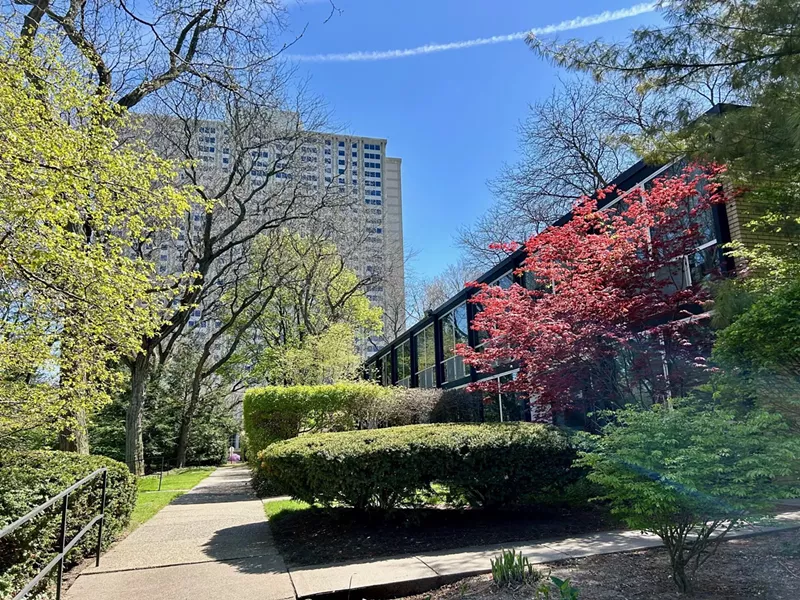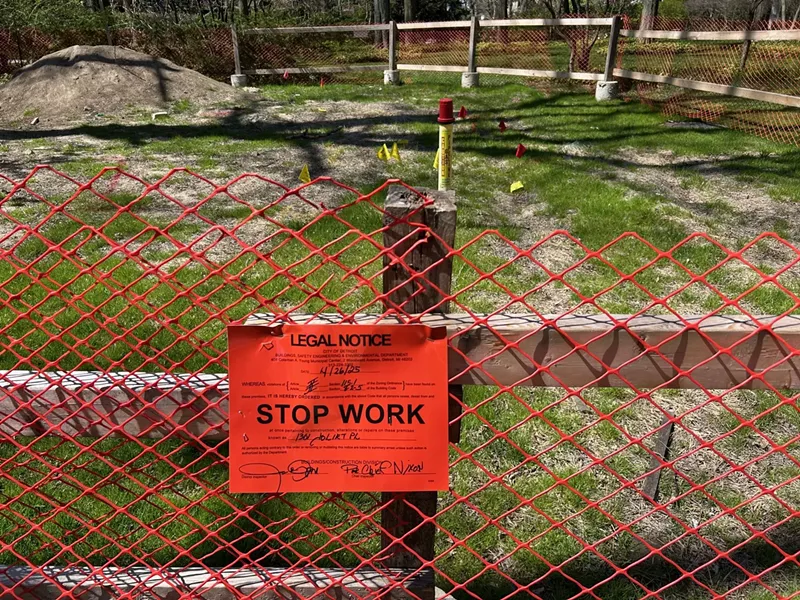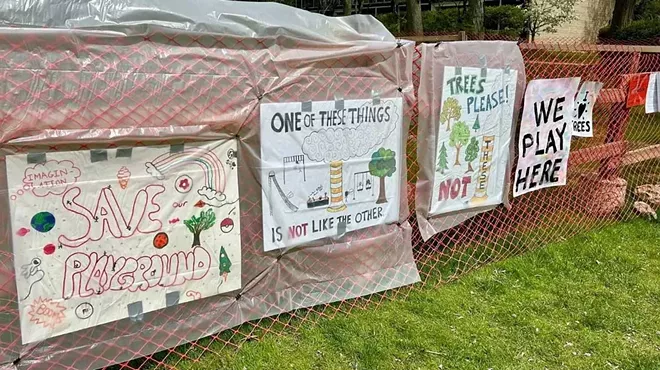Lafayette Park residents rise up as steam project threatens historic development
Detroit Thermal’s high-pressure steam would slice through a playground and endanger children and the historic character of the area, residents say

Audio By Carbonatix
[
{
"name": "GPT - Leaderboard - Inline - Content",
"component": "35519556",
"insertPoint": "5th",
"startingPoint": "3",
"requiredCountToDisplay": "3",
"maxInsertions": 100,
"adList": [
{
"adPreset": "LeaderboardInline"
}
]
}
]

This story was updated at 3:40 p.m. with a response from Detroit Thermal.
A battle is unfolding in picturesque Lafayette Park, where residents are trying to stop a private utility company from digging up parts of their nationally recognized neighborhood to install high-pressure steam infrastructure that they say would damage the historic character of the area and endanger children.
Detroit Thermal, which supplies steam-based heating to downtown businesses, wants to connect its existing network to the iconic 1300 Lafayette, a luxury apartment high-rise designed by renowned architect Gunnar Birkerts. The 30-story building, which has been experiencing boiler failures, is currently relying on rented boilers and seeks a permanent solution through Detroit Thermal.
But residents living nearby in the equally historic townhouses and courthouses say the project poses significant risks to the district’s unique landscape, safety, and historic character.
Detroit Thermal is relying on a decades-old easement to justify its work through residential parkland. But residents argue the easement was intended for public utilities, not private companies like Detroit Thermal, and that no clear legal agreement gives the company the right to install new steam infrastructure, especially in a historic district. Even if the easement exists, it does not authorize installing dangerous high-pressure steam lines, residents say.
In late August 2024, without a clear explanation to residents, crews for Detroit Thermal crews began excavation near a heavily used neighborhood playground, blocking access, damaging a 50-year-old star magnolia tree, and abandoning the site for months, according to residents. A sign reading, “CAUTION HOT DO NOT TOUCH,” appeared, alarming residents who found children playing near the excavation. Children’s toys were left behind in the fenced-in area. Residents reported that a 50-year-old star magnolia tree was severely damaged during the work, with branches ripped off by hand. Dirt piles created by the excavation became an impromptu play area for children.
“The playground is the epicenter of daily play, birthday parties, dog walks, picnics, Easter egg hunts, Halloween festivities, ball games, tree climbing, mock battles, epic hide-and-go-seek games, hopscotch, and sprawling chalk art installations,” residents wrote in a complaint to the Detroit Historic District Commission. “It is a magical place to be a kid. It should not be ruined by billowing clouds of steam that cause second-degree burns."
In response to resident concerns, Detroit Thermal said in a statement to Metro Times that it is working on possible alternatives and has no intention of placing dangerous infrastructure near the playground.
“We will keep any above-ground steam pipes a safe distance from the playground,” the company said. “We’re investigating an alternative that would eliminate the steam pipes all together.”
After the excavation site was fenced off, residents say Detroit Thermal did not return to complete the work or respond to their calls until March 12.
Then on Saturday, city officials posted a stop work order at the excavation site. David Bell, director of the Buildings, Safety Engineering, and Environmental Department, confirmed the halt.
“The City of Detroit Building Safety, Engineering & Environmental Department (BSEED) has issued a stop work order preventing the Detroit Thermal company from continuing work on installation of a new service line in the area of the Lafayette Park historic district,” Bell said in a statement. “The Department of Public Works also will be suspending Detroit Thermal’s work permit. The City has determined the Historic District Commission must approve key aspects of the Detroit Thermal work plan.”

It remains unclear why the Department of Public Works approved the work initially. The city declined to comment.
Residents were further alarmed on March 17 when Detroit Thermal contractors told them they planned to move forward with a much larger excavation that would slice through a playground and require installation of steaming manhole covers and steam vents, according to residents.
Beverly Brown, who has lived in Lafayette Park since 1961, says the playground is vital to the residents and their children. She vividly remembers playing with dozens of children at the playground when she was a child.
“That playground is the heart of the neighborhood,” Brown tells Metro Times. “This is essential and central to who we are. To put an exhaust system next to a playground is ridiculous.”
Brown adds that residents are prepared to dig in for a fight.
“This is a very activist community,” she said. “We aren’t going to take this lying down.”
Peter Souza, a resident at 1300 Lafayette, counters that occupants of the high-rise need a long-term heating solution after their boilers failed and the building had to rely on expensive temporary rentals.
“We need to heat our building,” Souza tells Metro Times. “Our boilers failed, and we’ve been renting temporary boilers, and this is really the most cost-effective way for us to do this. We have people in this building since it was built in 1964.”
Souza insists the fears are overblown.
“What we’re trying to do is repurpose and use it again. Everything that is being done and considered for this project is being considered with safety first,” Souza said. “The idea that children are going to get harmed in the playground or anything else like that is really just reactionary.”
He adds, “In essence, they can’t stop anybody from using an easement. The historic nature of the property is not going to be hurt at all. All of this stuff was here to begin with.”
Residents of the townhouses disagree. In a formal complaint to the Detroit Historic District Commission, residents argued that the project would cause “significant” and “irreversible” damage to the protected landscape, including the potential loss of five 60-year-old honey locust trees — key elements of the neighborhood’s historic canopy.
“Detroit Thermal now plans to create several new excavations that would significantly damage historic landscape features, including the potential loss of up to five 60-year-old honey locust trees that are a major highlight of the historic district and other original landscape features,” residents wrote. “Further, and most troubling, during these excavations Detroit Thermal plans to install new infrastructure under two neighborhood playgrounds, and the new infrastructure would include the installations of several manholes that would have an elevated temperature of up to 350 degrees Fahrenheit and constantly be emitting steam.”
Residents also raised serious safety concerns. They pointed to a 2020 lawsuit filed by Buckfire Law on behalf of 37 people, including children, who suffered second- and third-degree burns from contact with Detroit Thermal’s steam infrastructure downtown.
They also cited catastrophic failures of similar steam systems in other cities. In 2007, a steam pipe explosion in Manhattan launched a 40-story geyser of debris, killing one person and injuring 45 others. Other explosions have occurred in Baltimore, Boston, and Philadelphia — all involving pipes located under streets, not playgrounds.
Residents say Detroit Thermal’s plan is unprecedented because it involves a large swath of historic, residential property.
“With this project, Detroit Thermal intends (for the first time) to bury high-pressure steam pipes under a residential neighborhood and directly under an active playground,” residents wrote. “It is not clear what kind of catastrophic damage a steam pipe explosion under a residential neighborhood would cause, but the Historic District Commission has the power to stop residents of the city of Detroit from having to find out.”
At the heart of residents’ complaint is the assertion that Detroit Thermal has operated in bad faith. According to the letter to the Historic District Commission, Detroit Thermal failed to obtain the necessary permits, failed to notify the Historic District Commission, failed to communicate with residents, and misrepresented the nature and extent of the project to the residential co-ops.
Since August, Detroit Thermal has conducted four separate excavations in the neighborhood without proper permits, residents allege.
“All four excavations were done without proper permits or approval from the Historic District Commission. They now sit fenced-off and abandoned,” the letter states.
Residents argue that the steam project violates federal standards for rehabilitating historic properties, including prohibitions against significantly altering historic features, destroying historic materials, or introducing new elements that are inconsistent with a property's historic use.
“One of the most historically significant characteristics of the neighborhood is the absence of automobile traffic, including many of the trappings of the urban street grid,” residents wrote. “There are no traffic lights, no crosswalks, parking meters, overpasses, billboards, commercial signage of any kind, bus stops, or steam vents. The characteristic urban ‘Gotham-style’ steam vent emitting huge, billowing clouds of steam is antithetical to the very idea of why Lafayette Park was developed and how it has evolved in its historical setting.”
On Monday, Detroit City Council President Mary Sheffield held a Zoom call with residents of the townhouses and 1300 Lafayette to hear concerns. Sheffield said her office could not divulge much information because of the possibility of a lawsuit.
“We are bound legally by not being able to say much,” Bruce Simpson, the city of Detroit’s ombudsman, told residents on the call. “I hate that we can’t. Know that we’re working on it.”
Sheffield’s chief of staff, Brian H. White, said Detroit Thermal contends it does not need permission from the Historic District Commission.
“They state they are willing to pursue any legal remedies,” White said.
Residents from both the townhouses and the high-rise spoke up during the meeting.
Arlene Frank said she moved to Lafayette Park for its “incredible park-like setting” and warned that the project would “incredibly and extensively impact the cooperative neighborhood here in Lafayette Park.”
A 12-year-old resident also spoke, emphasizing the importance of the playground to growing up in the neighborhood.
“I’ve been there for many years, and I want the younger generations to have that to hang out with their friends,” the child said. “There have to be other solutions, not tearing up this historic place and also a playground where a lot of kids are hanging out.”

Some residents of 1300 Lafayette said they were open to discussions about finding a better solution. Connie Harris said she initially believed Detroit Thermal was operated by the city.
“We are also concerned about the young people,” Harris said. “And there are some processes that can take place where there could be a safer way and a less destructive way that things can take place.”
State Sen. Stephanie Chang, a Detroit Democrat, also joined the call and pledged to stay involved.
“I definitely want to make sure the safety of the kids and the environment are protected,” Chang said.
Designed beginning in the mid-1950s, Lafayette Park is considered one of the most successful post-World War II urban redevelopment projects in the U.S. The 46-acre site includes townhomes, high-rises, parks, and green spaces, and is the world’s largest collection of buildings by Ludwig Mies van der Rohe, a German-American architect and a master of modernist design known for his exposed steel frames and glass façades.
While Lafayette Park is often hailed as a model of urban renewal, it was built at the cost of displacing the largely African-American residents of the former Black Bottom neighborhood, one of Detroit’s most significant Black communities, razed in the name of modernization.
Today, Lafayette Park remains a vibrant, highly occupied neighborhood, known for its peaceful green spaces and commitment to preserving its historical integrity.
Whether that character will be changed permanently by the steam project may ultimately fall to a court to decide.
Unless something changes, White told residents, “I firmly believe the matter is going to have to end up in court and a judge is going to have to decide on the enforcement piece.”
In its statement, Detroit Thermal defended the controversial project, saying the utility upgrade is necessary to restore sustainable heat to 600 residents at 1300 Lafayette, a building previously disconnected from the city’s steam system in favor of boilers that have since failed.
“The Cooperative board asked Detroit Thermal to reconnect the building because the current boiler system is not sustainable,” the company said. “The 600 residents desperately need a heating solution for the coming winter.”
Detroit Thermal said the project was approved by both the city of Detroit and the Michigan Public Service Commission, which regulates utilities for safety and reliability.
“An important and beneficial project to the Lafayette Park neighborhood, the City of Detroit approved the project with no objections,” the company said.
The company added that its newer pipes are safer than the older steam infrastructure found downtown and that it has invested in modern safety systems.
“The steam pipes now used by Detroit Thermal are shorter and thinner than those in downtown Detroit and do not give off heat,” the statement said.
Finally, the company urged residents to consider the needs of those living in the high-rise.
“We ask those concerned by this utility upgrade to respect the needs and wishes of their neighbors at 1300 Lafayette,” the company said. “We are working with the city and our neighbors to make sure 1300 Lafayette gets the clean, safe energy it needs in a way that strengthens the entire Lafayette Park community.”







